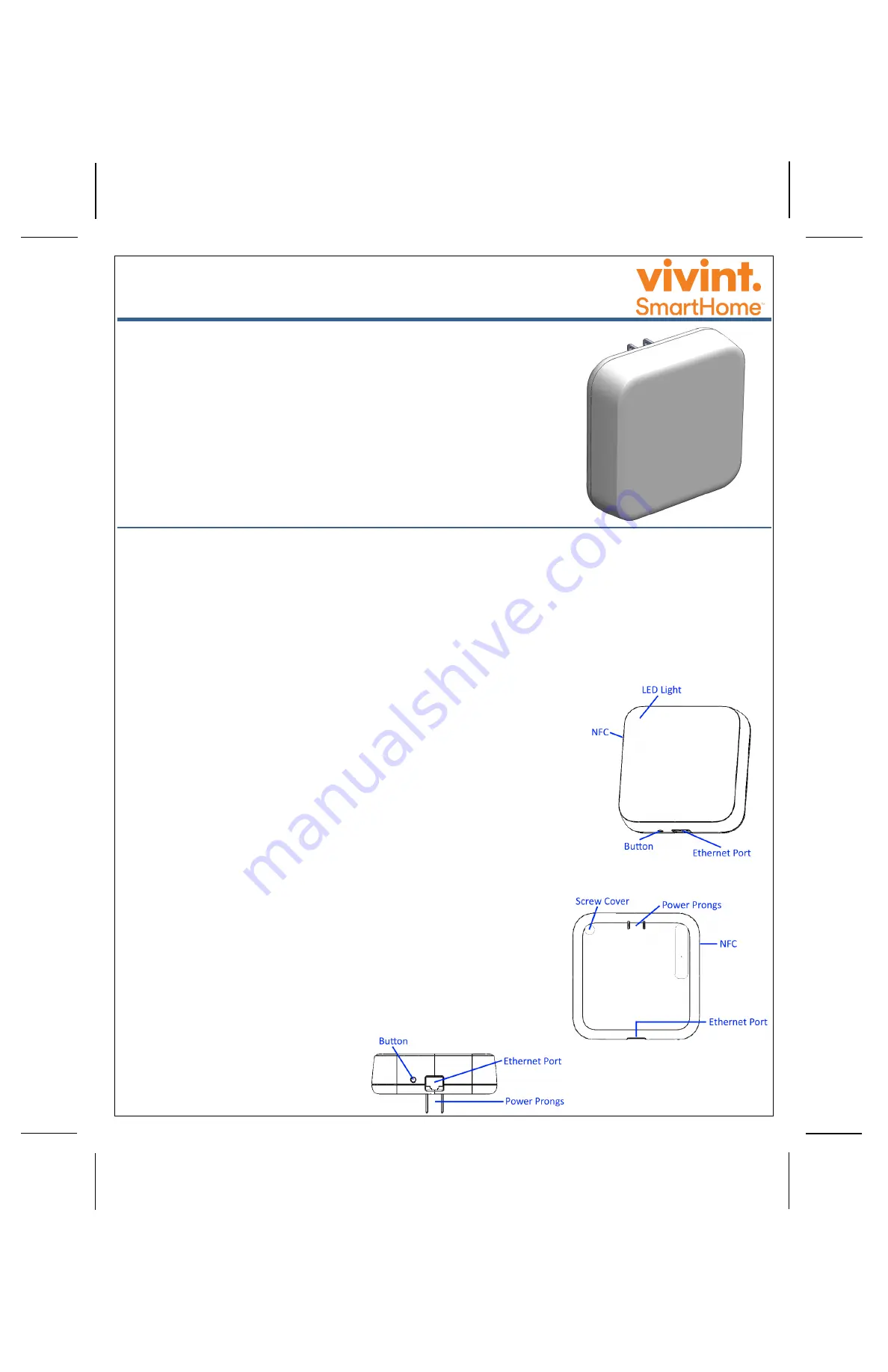
Installation Instructions Outline
Installing the AirBridge node is simple and straightforward, and can be quickly learned and mastered. As noted, you can install multiple VAB nodes to a Vivint
system that is based on the Smart Hub control panel (SkyControl is not supported) if warranted by the home environment and size and scope of the system.
IMPORTANT:
In order to configure the secure dedicated Vivint network, either the initial AirBridge node or the Smart Hub panel itself must be hardwired to
the home's broadband internet router via an Ethernet connection, designating that hardwired component as the network's single portal
node. To be clear,
only one portal node is allowed on the Vivint network, and the Ethernet port on the VAB can be used for connection only when it is acting as that portal node.
The Vivint technician should carefully read these steps in order to ensure a successful installation and optimal performance. For additional information, including
details for specific network configurations and troubleshooting guidelines, refer to the
Field Service Smart Home Pros
website.
Bottom View —
The Vivint AirBridge™ wireless mesh node is a connectivity device that can be added to the homeowner's Vivint Smart
Home system. This proprietary 5GHz Wi-Fi solution creates a secure mesh network dedicated to a Vivint system with
the Smart Hub panel and connected devices such as cameras, sensors, etc. Vivint AirBridge is not supported on the older
SkyControl panel. Adding Airbridge node(s) to configure a dedicated Vivint network eliminates bandwidth sharing on the
local network, worry about rogue devices, and the need for third-party hardware such as repeaters, extenders, etc.
You can, if necessary, add more than one node to the system in order to expand coverage for the Vivint network (see
below for details). AirBridge optimizes network traffic; increases signal strength between cameras and the panel,
enhancing video quality; and improves the speed, reliability, and control of the overall Vivint smart home experience.
Vivint AirBridge (VAB) is professionally installed by a Vivint Field Service Pro (FSP) technician. VAB nodes are added to
the system via either NFC or WPS. Features include an LED light that indicates function and status; and a multi-function
button that lets you toggle the LED on/off, send a WPS signal to the panel, and reboot or reset the node. Once installed
and configured, AirBridge nodes operate seamlessly and transparently in improving every aspect of the Vivint
network/system. In other words, when functioning properly AirBridge requires very little if any end user interaction.
This document includes a product description overview, key features, illustrations, installation and test instructions, as
well as technical specifications, standards certifications listings, and regulatory notices and declarations.
Vivint AirBridge Wireless Mesh Node
(VS-YOFIMN-000)
Quick Reference (Overview, Installation, Specs, Regulatory)
PRINT INSTRUCTIONS:
REFERENCE SHEET FOR VS-YOFIMN-000, DOCUMENT P/N 77-600036-001 REV 1.0 |
INK:
BLACK |
MATERIAL:
20 LB MEAD BOND |
SIZE:
8.50" X 11.00" SCALE 1:1 |
FOLDS:
BI-FOLD VERTICAL, BI-FOLD HORIZONTAL (TO FIT IN BOX)
Follow these steps to pair a VAB node and add it to the system:
1.
First, change the panel connection type to AirBridge mode.
At the panel, tap on the menu icon (…) in the
bottom right corner > tap
Software version
> enter the PIN code
2203
to access the Installer Toolbox > tap
Networking
> and then select
AirBridge
. Press
Back
> and then press
OK
to confirm the change.
IMPORTANT:
Do NOT reboot the panel during the AirBridge node installation process. Once the node(s)
are installed, the network connection status will update to show the new connection type.
2.
Pair the VAB node to the panel via NFC
. In the Installer Toolbox > tap
Networking
>
Add AirBridge
>
NFC
>
and then tap
Add
. Align the upper left side of the VAB node with the white LED light in the bottom right
corner of the panel, and hold it in physical contact with the panel until pairing is complete (this may take
several minutes, make sure to wait until prompted that the node is successfully paired).
NOTE:
If NFC doesn't work you can use WPS, making sure to first plug in the VAB node (powered on) and
then press the button on the bottom of the node for 3-5 seconds to send a WPS signal to the panel.
3.
Name each VAB node that you add. In the Installer Toolbox > tap
Networking
>
Advanced Networking
>
AirBridge Node View
. Tap the node and then its name field to enter a unique descriptive name (based on its
location and function as either a
portal
or
point
node).
4.
Install the VAB node
. Plug the node directly into an unswitched wall outlet.
NOTE:
If the panel is wirelessly connected to the home router, you must install the first VAB node (as the
network's single
portal
node) where it can be directly connected to the router via the Ethernet port.
However, if the panel is hardwired to the router, you should install the first VAB node and subsequent
nodes (as network
point
nodes) in a location that best enhances network performance, such as in between
a camera with a weak signal and the panel. You can use the AirBridge Network Graph tool (on the
Networking page) to both view the network and to determine how many nodes are needed and where
they should be installed for optimal coverage. See the
Field Service Pros
website for details and examples.
5.
Verify power is present at the node. The LED will illuminate white. (See LED descriptions.)
6.
Wait for the node to establish a connection to the panel and update its firmware. The LED will illuminate
green. This may take several minutes, make sure to wait until prompted that the node is connected.
7.
If after running the Network Graph tool you need to install multiple nodes, follow the same steps as above.
8.
Once finished, the panel will automatically configure all of the nodes on the Vivint network.
Back View —
Front View —
Button Functionality
The button located on the bottom of the AirBridge node can
perform multiple functions, as described below.
•
Press & let go quickly
— Toggles on/off the LED light
•
Press & hold for 3-5 seconds
— Sends a WPS signal
•
Press & hold for 10 seconds
— Reboots the node
•
Press & hold for 20 seconds
— Factory resets the node




















